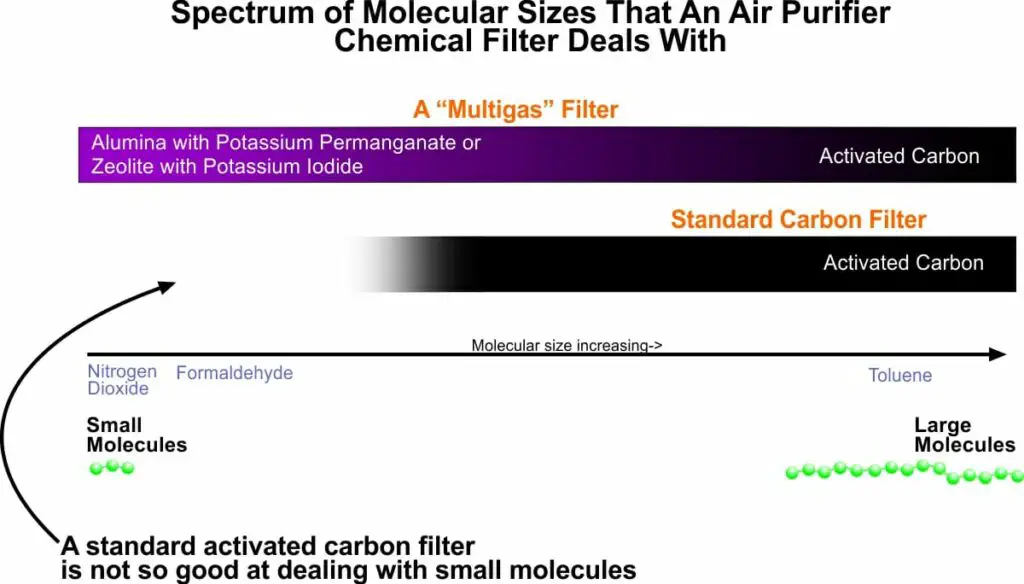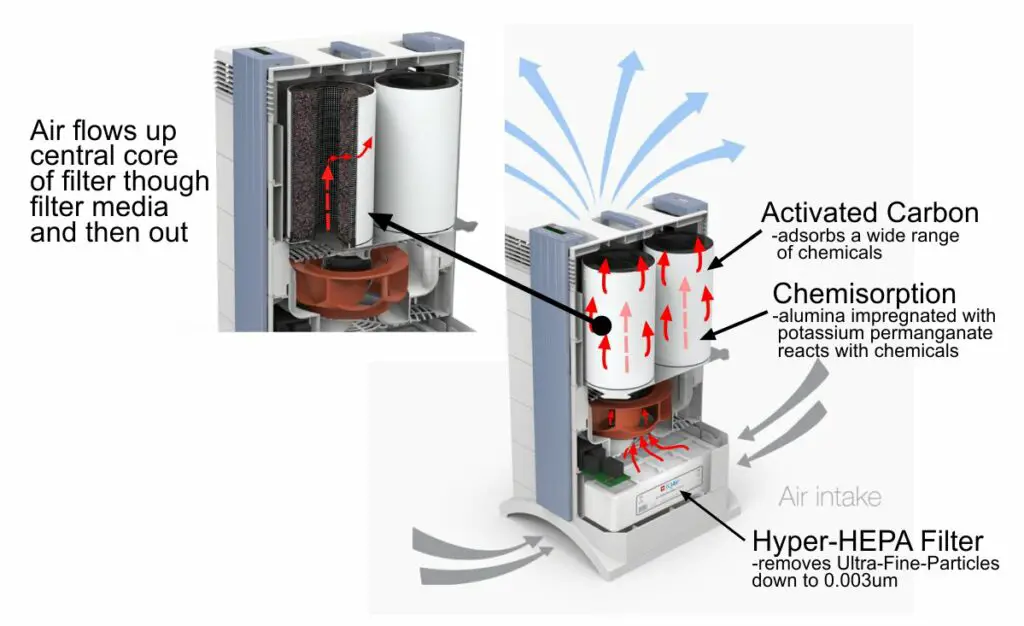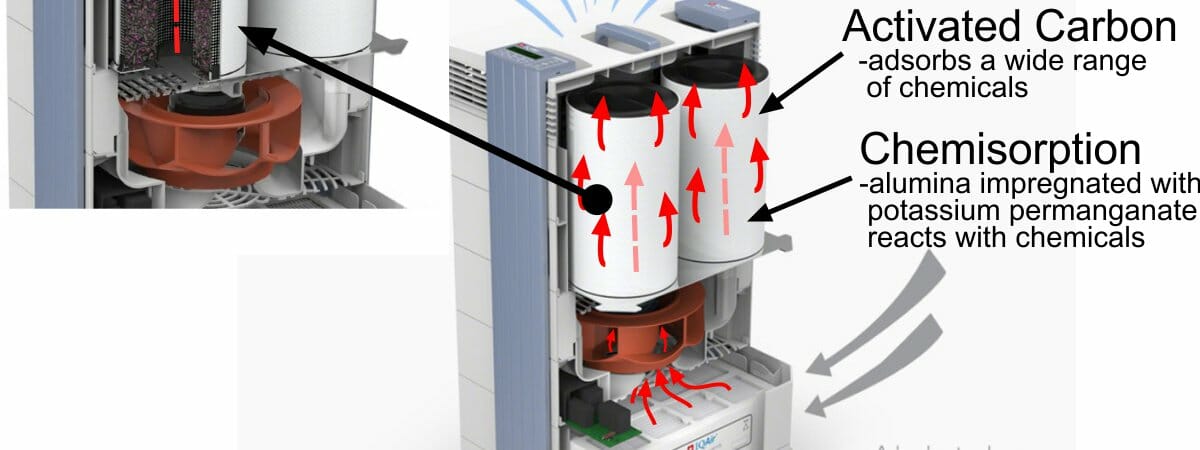Formaldehyde is used in the manufacture of many household products, for instance, furniture and remodelling or construction of a home. It is also been linked to adverse health effects and even cancer. So it is natural to consider whether an air purifier/air cleaner is necessary and if so which is the best air purifier for formaldehyde removal.
On the whole, the IQ air Multigas is the best air purifier for formaldehyde from the air. Formaldehyde is a small molecule and the standard carbon filter that is found in most air purifiers will not remove it well.
A purely PECO air purifier is also worth considering in addition, but not on its own. This is because there is evidence that pure PECO air purifiers do not remove airborne particles well (please see below). Also worth considering is the Dyson Hot-Cool Formaldehyde air purifier (discussed below).
So let’s consider the likely risks to health, whether it affects you and why the IQ air Multigas is the best air purifier for removing formaldehyde and other small molecules-
Formaldehyde-the largest airborne contributor to cancer risks other than tobacco smoke
Formaldehyde has a boiling point of -19oC and so is typically a gas at temperatures that we experience, so it is a volatile organic compound (VOC). It can be found at significant levels in some homes and can cause irritation of the airways. However, the most serious risk is that of cancer.
One study calculated the exposure to 12 VOCs. Formaldehyde and paradichlorobenzene were the most important chemicals contributing to cumulative cancer risks , but acetaldehyde chloroform and benzene also contributed. Risk estimates among the 10% of Hispanics with the most exposure were greater than one in a thousand. This may not sound like much, but it means for every 1000 households, formaldehyde in the atmosphere was associated with an extra cancer. Formaldehyde was the largest contributor amongst VOCs to cancer risk for almost 90% of whites and 70% of Hispanics.
The most common cancer associated with formaldehyde inhalation is nasopharyngeal cancer. There are studies that go either way regarding the role of formaldehyde in causing leukemia. Although a study showing chromosomal changes in the bone marrow suggests that there could well be a link. Fortunately, the risk of developing a lower respiratory tract cancer from breathing in formaldehyde is low. For a fairly typical formaldehyde concentration of 30 ppb the risk is of the order of 1 million after 80 years of exposure. However, for higher concentrations, the risk can obviously be much higher.
Sources
Formaldehyde is used in a number of building and consumer products-
| Building Materials | Consumer Products | Indoor Activities |
|---|---|---|
| Wood-pressed wood, plywood | Cosmetics | Tobacco smoking |
| Glues | Dish soaps | Marijuana smoking |
| Adhesives | ||
| Paints-some | Fabric softerners | Fires-burning wood, paper other organic fuel |
| Insulation materials | Leather | |
| Permanent press fabrics | ||
| Furniture |
Reduction/Avoidance
As formaldehyde is an airborne chemical at temperatures above -19oC, it can evaporate from an object and be blown away in the open air. So by leaving objects in the open air formaldehyde will constantly evaporate from them and be blown away “off gassing”. Ideally give building materials that release formaldehyde an ” off-gassing ” period in a garage or warehouse before installing them in your home. If this is not possible, you should ventilate the house well, especially during the first few weeks. Try to avoid glues adhesives and paints which release formaldehyde. Also, keep newly manufactured furniture in a garage not in connection with the house for a few weeks to off-gas before putting it in the home.
Ideally use cosmetics, soaps and fabric softeners with a minimum formaldehyde content. This is easier said than done as manufacturers may not wish to advertise the amount of formaldehyde that their product emits. Here is a table of formaldehyde equivalent names or formaldehyde producing preservatives-
| Name of Ingredients Indicating That Formaldehyde is Present | Name of Ingredients Indicating That a Chemical That Can Realease Formaldehyde is Present |
|---|---|
| Formalin | Benzylhemiformal |
| Formic aldehyde | 2-bromo-2-nitropropane-1,3-diol |
| Methanediol | 5-bromo-5-nitro-1,3-dioxane |
| Methanal | Diazolidinyl urea |
| Methyl aldehyde | 1,3-dimethylol-5,5-dimethylhydantoin (or DMDM hydantoin) |
| Methylene glycol | Imidazolidinyl urea |
| Methylene oxide | Sodium hydroxymethylglycinate |
| Quaternium-15 |
So it is not easy to make sure that we are avoiding formaldehyde.
Ideally let all the formaldehyde/VOCs evaporate “off-gas” from leather in a garage for several weeks before moving it into the home. Permanent press fabrics should be washed straightaway after buying them to remove the formaldehyde.
Wood, coal etc should not be burnt indoors.
Home Measurement of Formaldehyde
Before buying an air purifier specifically for removing formaldehyde it is good idea to measure the formaldehyde levels in your home. Unfortunately, meters for measuring VOCs and formaldehyde can be very expensive. They do not measure specific VOCs but give a total amount of VOC in the air, part of this will be formaldehyde which can be measured specifically.
A practical meter for measuring formaldehyde is the Temptop 1000 S –

and the total VOC (TVOC) reading at the bottom
The safe levels specified for this meter are as outlined below-
| HCHO (Formaldehyde) mg/m3 | (Total VOC) mg/m3 | |
|---|---|---|
Healthy | 0-0.1 | 0-0.6 |
| Unhealthy | >0.1 | >0.6 |
This is a practical way of assessing VOC levels in your home.
If You Do Need an Air Purifier to Remove Formaldehyde-
The IQ air Multigas is the best air purifier for removing VOCs and formaldehyde. This is by adsorption with activated charcoal and chemical interaction, that is oxidation, with potassium permanganate.

Choosing an Air Purifier to Remove Formaldehyde
The chemical filter should ideally have both activated carbon and also an oxidising agent such as alumina impregnated with potassium permanganate. The filter should also contain as much filter media as possible.
Although formaldehyde is damaging to human health, there is even more evidence that fine and ultrafine particles damage many aspects of the human body particular the heart and circulation, and brain. So, when buying any air purifier an important aspect of their machine is the airborne particle filtration. The basic standard is a true-HEPA filter (HEPA H13) which removes coarse, fine and some ultrafine particles all of which damage human health. So in choosing an air cleaner we also need one which has an excellent particle filter.
Overall Best Air Purifier for Formaldehyde and VOCs in General-the iQair Multigas (Serves 200 sq ft* per machine)
The air coming out of this air purifier has higher specifications than any other air purifier on the market. It is specified to remove 99.5% of particles greater than 0.003um, the best particle specification on the market. It also has the second largest activated carbon filter on the market which is further improved by adding potassium permanganate which oxidises formaldehyde. So its removal of chemical compounds may well be the best on the market as well, there is only one other air purifier that comes close, the Austin Air Healthmate series. So it is an excellent air purifier for dealing with both common aspects of air pollution.
It really is an air purifier specialised in removing chemicals from the air.
No pre-filter cleaning needed, this is a significant advantage as almost all other air purifiers have a type of pre-filter which should theoretically be cleaned every 2-4 weeks.

| Filters | |
| HEPA filter | HEPA specified to remove 99.8% of ultrafine particles down to a size of 0.003um |
| Carbon filter amount of carbon (lb) | 12 lb so so 100x more than some other air purifiers |
| Filter Change HEPA (Particles) | 12 months |
| Filter Change Carbon (Chemicals) | 29 months |
| Airflow | |
| CADR at =<50db (CADR on Maximum) | 170 cfm |
| Maximum Room Size (Noise less than 50db*) | 262 sq ft |
| Maximum Room Size (On noisiest setting) | 462 sq ft |
| Smart Control | Yes smart plug |
| Power | 74 W |
| Weight | 44 lbs |
| Dimensions “H x “W x D” | 28x 15 x 16 |
| Annual Running Cost Electricity ($) | $45 |
| Annual Running Cost Filters ($) | $285 |
| Total Annual Running Cost ($) | $330 |
All the above are approximate and assume running the air purifier for 12 hours per day on the highest setting that keeps the noise below the level specified in db in the table. This is less than or equal to 50db in normal daytime use and 35db for bedrooms.
*Most people will not wish to have the air purifier on a setting louder than about 35db for sleeping in a bedroom-you may wish to have a quieter setting than 35db this is just a ballpark estimate for most people. On the other hand, if your room layout allows you to be much further than 6 feet from the air purifier you may find the noise this machine makes at top speed is alright. The calculations for room size assume that you have 8 foot ceilings and 5 air changes per hour.
Never run an air purifier on auto mode using the inbuilt sensor. These cannot detect ultrafine particles which are damaging to human health, please see this article- How to test the air quality in your home.
All the above are approximate and assume running the air purifier for 12 hours per day on the highest setting that keeps the noise below the level specified in db in the table. This is less than or equal to 50db in normal daytime use and 35db for bedrooms.
*Most people will not wish to have the air purifier on a setting louder than about 35db for sleeping in a bedroom-you may wish to have a quieter setting than 35db this is just a ballpark estimate for most people. On the other hand, if your room layout allows you to be much further than 6 feet from the air purifier you may find the noise this air purifier makes at top speed is alright. The calculations for room size assume that you have 8 foot ceilings and 5 air changes per hour.
Never run an air purifier on auto mode using the inbuilt sensor. These cannot detect ultrafine particles which are damaging to human health, please see this article.
Second Best Air Purifier for VOCs (Serves 262 sq ft* per machine)
iQair HealthPro Plus (second best chemical filter specification and supreme particle filter)
This air purifier is more affordable than the iQair Multigas and has a better carbon filter than most other air purifiers. It is only suitable for rooms up to 262 sq ft, assuming the room has 8ft ceilings unless you are very tolerant of noise.
Advantages
No pre-filter cleaning needed, again quite an advantage as most air purifiers have pre-filters which should theoretically be cleaned every 2-4 weeks!

Advantages
| Filters | |
| HEPA filter | HEPA specified to remove 99.8% of ultrafine particles down to a size of 0.003um |
| Carbon filter amount of carbon (lb) | 5 lb so 40x more than some other air purifiers |
| Filter Change HEPA (Particles) | 15 months for pre filter 48 months for Hyper-HEPA filter |
| Filter Change Carbon (Chemicals) | 20 months |
| Airflow | |
| CADR at =<50db (CADR on Maximum) | 170 cfm |
| Maximum Room Size (Noise less than 50db*) | 262 sq ft |
| Maximum Room Size (On noisiest setting) | 462 sq ft |
| Smart Control | Yes smart plug |
| Power | 74 W |
| Weight | 35 lbs |
| Dimensions “H x “W x D” | 28x 15 x 16 |
| Annual Running Cost Electricity ($) | $45 |
| Annual Running Cost Filters ($) | $180 |
| Total Annual Running Cost ($) | $230 |
There is a more extensive review of this air purifier here.
The Austin Healthmate series of air purifiers have very large carbon filters. However, they do not quote the CADR for their air purifiers. The EPA recommend sizing air purifiers to rooms using the CADR. So the CADR is important consideration for consumers and buying an air purifier. The CADR clean air delivery rate is basically the amount of air cleaned adequately per unit time. Further details about it can be found in this article –The CADR Rating of an Air Purifier-the most important statistic? I personally do not recommend air purifiers as the only air purifier in a room if the manufacturer will not quote the CADR as it makes me wonder if the reason for not quoting it is that the CADR is not very good.
There are alternatives to carbon filter technologies-
- Photoelectric catalytic oxidation, ie PECO (MoleKule air purifier)-these air purifiers use photocatalytic oxidation to destroy formaldehyde. The problem is that these air purifiers have been reported to be poor at reducing airborne fine particle count.
- Catalytic tunnels (Dyson Hot-Cool Formaldehyde air purifier) – these convert formaldehyde into harmless carbon dioxide and water. They self regenerate and so never need replacing. The problem with the Dyson air purifiers is that traditionally they do Give CADR ratings it is therefore impossible to check if there an appropriate size for your room according to EPA (Environmental Protection Agency) methodology. Independent tests have reported that the CADR of Dyson air purifiers to be significantly lower than other machines at their price point. My understanding of Dyson’s rationale for not giving a CADR is as follows. They have tested their air purifiers and found that the air currents that they create within the room will mean that even if all the air in the room is not perfectly purified overall the air that is circulating where you are breathing will be purified.
Ventilation is VERY Important
The concentration of formaldehyde in your outdoor air will be almost negligible probably of the order of 0.001 mg/m³. The concentration in your home will be much greater, as I write this article in the room I am sitting in it is 0.014 mg/m³. So simply letting air escape from your home and clean air enter will be one of the most effective ways of reducing formaldehyde concentration in your home.
So although it is easy to forget, ventilation of your home with fresh air every so often is really important.
Rather than simply ventilating every so often, fairly continuous ventilation can be done by air exchange. There are air exchange units which incorporate heat exchange elements. In these the air leaving the home goes through a radiator like device and the air entering the home flows over the radiator and so before it enters the home its temperature becomes more to that of the home air.
This saves having to heat or cool the air entering the home so much, and so is more energy-efficient.
Conclusion
There is no doubt that formaldehyde is a potential health hazard, however it may not be a hazard in your home. The first thing is to check formaldehyde levels in the air in your home which may well be fine.
If you do find that you have an unhealthy formaldehyde level, then ideally you would find the source and eliminate it. This may not be possible, for instance, in a newly built home. Then you may wish to consider one of the carbon filter based air purifiers above for any of the rooms in which you spend a significant amount of time. Overall the iQair Multigas is the best air purifier for formaldehyde removal whilst still removing airborne particles and other airborne chemicals so improving your indoor air quality in general.
You could also add an additional air purifier based on different technology PECO (Molekule) or catalytic tunnels (Dyson) in the main rooms. The aim of this would be to lower the level of formaldehyde further and in a way that will continue to work even if the carbon filter becomes saturated with formaldehyde and stops removing it.
Finally, always remember that ventilation is a very effective way of removing any VOC from a home including formaldehyde. The problem is once you stop ventilating the level will start to rise again.

